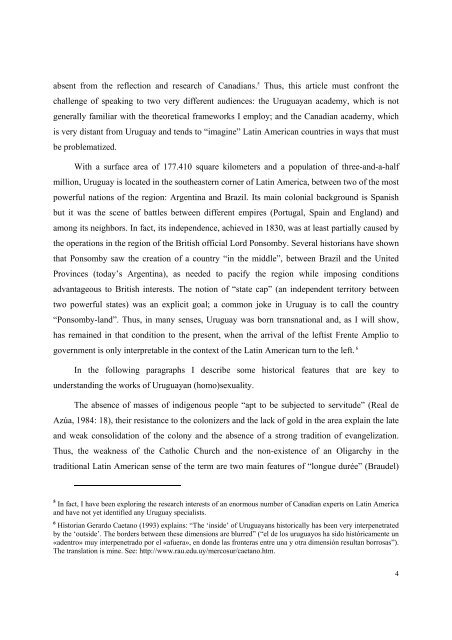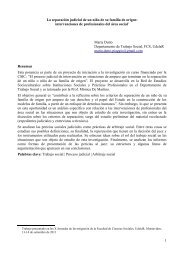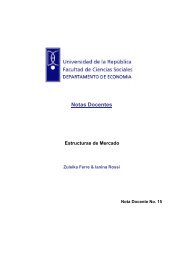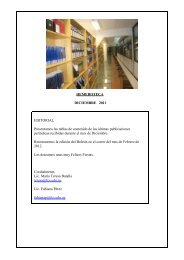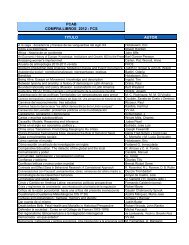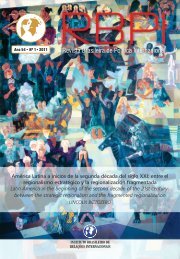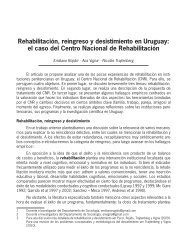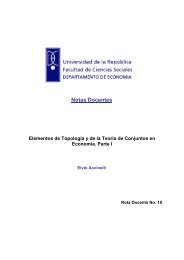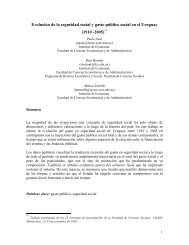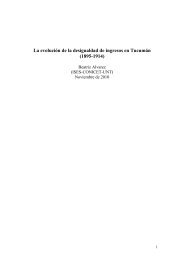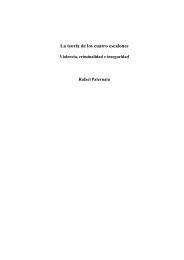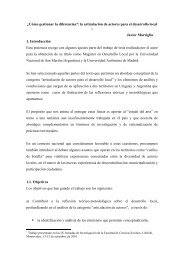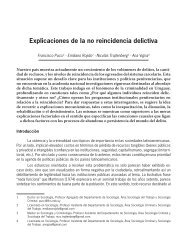Paulo Ravecca - Facultad de Ciencias Sociales
Paulo Ravecca - Facultad de Ciencias Sociales
Paulo Ravecca - Facultad de Ciencias Sociales
Create successful ePaper yourself
Turn your PDF publications into a flip-book with our unique Google optimized e-Paper software.
absent from the reflection and research of Canadians. 5 Thus, this article must confront the<br />
challenge of speaking to two very different audiences: the Uruguayan aca<strong>de</strong>my, which is not<br />
generally familiar with the theoretical frameworks I employ; and the Canadian aca<strong>de</strong>my, which<br />
is very distant from Uruguay and tends to “imagine” Latin American countries in ways that must<br />
be problematized.<br />
With a surface area of 177.410 square kilometers and a population of three-and-a-half<br />
million, Uruguay is located in the southeastern corner of Latin America, between two of the most<br />
powerful nations of the region: Argentina and Brazil. Its main colonial background is Spanish<br />
but it was the scene of battles between different empires (Portugal, Spain and England) and<br />
among its neighbors. In fact, its in<strong>de</strong>pen<strong>de</strong>nce, achieved in 1830, was at least partially caused by<br />
the operations in the region of the British official Lord Ponsomby. Several historians have shown<br />
that Ponsomby saw the creation of a country “in the middle”, between Brazil and the United<br />
Provinces (today’s Argentina), as nee<strong>de</strong>d to pacify the region while imposing conditions<br />
advantageous to British interests. The notion of “state cap” (an in<strong>de</strong>pen<strong>de</strong>nt territory between<br />
two powerful states) was an explicit goal; a common joke in Uruguay is to call the country<br />
“Ponsomby-land”. Thus, in many senses, Uruguay was born transnational and, as I will show,<br />
has remained in that condition to the present, when the arrival of the leftist Frente Amplio to<br />
government is only interpretable in the context of the Latin American turn to the left. 6<br />
In the following paragraphs I <strong>de</strong>scribe some historical features that are key to<br />
un<strong>de</strong>rstanding the works of Uruguayan (homo)sexuality.<br />
The absence of masses of indigenous people “apt to be subjected to servitu<strong>de</strong>” (Real <strong>de</strong><br />
Azúa, 1984: 18), their resistance to the colonizers and the lack of gold in the area explain the late<br />
and weak consolidation of the colony and the absence of a strong tradition of evangelization.<br />
Thus, the weakness of the Catholic Church and the non-existence of an Oligarchy in the<br />
traditional Latin American sense of the term are two main features of “longue durée” (Brau<strong>de</strong>l)<br />
5 In fact, I have been exploring the research interests of an enormous number of Canadian experts on Latin America<br />
and have not yet i<strong>de</strong>ntified any Uruguay specialists.<br />
6 Historian Gerardo Caetano (1993) explains: “The ‘insi<strong>de</strong>’ of Uruguayans historically has been very interpenetrated<br />
by the ‘outsi<strong>de</strong>’. The bor<strong>de</strong>rs between these dimensions are blurred” (“el <strong>de</strong> los uruguayos ha sido históricamente un<br />
«a<strong>de</strong>ntro» muy interpenetrado por el «afuera», en don<strong>de</strong> las fronteras entre una y otra dimensión resultan borrosas”).<br />
The translation is mine. See: http://www.rau.edu.uy/mercosur/caetano.htm.<br />
4


